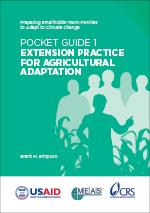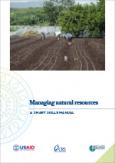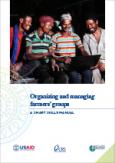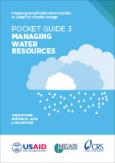Guidelines | March 9, 2016
Pocket Guide 1: Extension Practice for Agricultural Adaptation
This set of pocket guides, Preparing smallholder farm families to adapt to climate change, is written for field agents working in agricultural extension. The concepts, information and practices in these guides are meant to support their work to help farm families reduce their risks from changes in the weather. Many of the families who farm small, non‑irrigated plots in the tropics already struggle against poverty, degraded land, and rainfall that varies from year to year. This type of rainfed agriculture is especially vulnerable to climate change, although even irrigated agriculture can be vulnerable. The suggestions in these guides will help you work with farm families and rural communities to make changes in their farming systems that can withstand and are adapted to changing weather patterns.
These guides include practical methods that meet the objectives outlined by the Food and Agriculture Organization of the United Nations for climate‑smart agriculture (FAO, 2014a):
- Ways to increase agricultural productivity sustainably – practices that protect the environment and reduce poverty.
- Farming practices for individual farm families and communities to improve their resilience to climate change.
- Practices that can reduce some of the causes of climate change – decrease greenhouse gases to avoid contributing to further changes in the climate.
Preparing smallholder farm families to adapt to climate change is a set of five complementary guides:
- Extension Practice for Agricultural Adaptation
- Managing Crops
- Managing Water Resources
- Managing Soils
- Managing Livestock
The adaptation pocket guides follow a general four‑step approach developed for designing and implementing responses to climate change to help reduce the vulnerability of small‑scale farming systems. These steps are:
- Understand concepts: the effects of climate change on each guide’s focus area
- Assess climate change risks for each theme and appraise agricultural vulnerability
- Recommend practices for adaptation
- Mobilize community planning and action for adaptation





